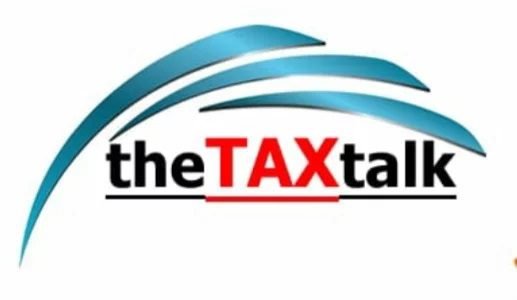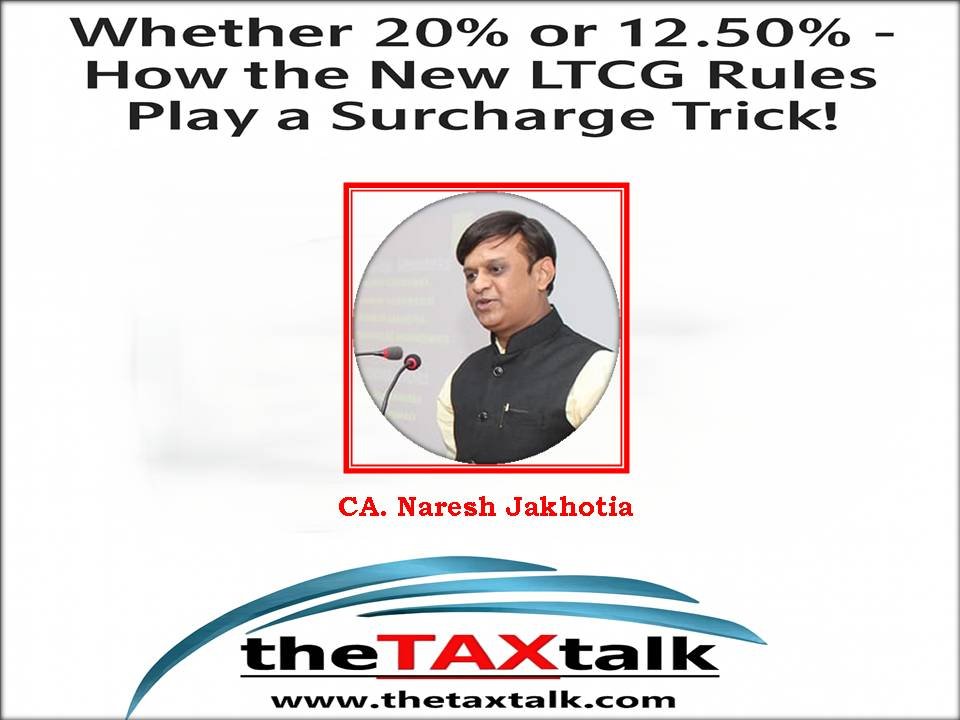![]()
Whether 20% or 12.50% – How the New LTCG Rules Play a Surcharge Trick!
When the Finance Minister first presented the Budget in July 2024, taxpayers were in for a shock – the indexation benefit on sale of property was gone. But during the passage of the Finance Bill on 7th August 2024, a new twist was introduced right on the floor of Parliament. Resident individuals & HUFs selling land or buildings (acquired before 23rd July 2024) would now get a choice:
1. Pay 12.50% tax without indexation, or
2. Pay 20% tax with indexation.
And, whichever option gives a lower tax, that would apply
Taxpayers applauded. Chartered Accountants smiled. Whatsapp forwards declared it “the taxpayer-friendly reform.” Finally, some freedom! But as every seasoned taxpayer knows, in income-tax law, if something sounds too good to be true, it usually comes with a footnote, provisos, and a small star to say that “Terms & Conditions apply”.
Indexation: The Genie That Went Back into the Bottle:
a)Before the Amendment:
Whenever the property is sold after holding it for more than two years, taxpayers used to get the indexation benefit. This simply meant that the purchase price was adjusted upwards for inflation using the Cost Inflation Index (CII). Let us understand it through a case study of Mr. A from Nagpur whose Business/Interest income for the FY 2024-25 is ₹12 Lakh. He has sold a plot in January-2025 for ₹75 Cr which was bought by him in April – 2001 for ₹ 75 Lakh. The taxable LTCG of Mr. A would be just ₹ 2.75 Lakh as a result of indexation benefit [i.e., ₹ 275 Lakh less ₹ 75 * 363/100]. At 20% tax, his LTCG tax liability would be just ₹ 55 K only (ignoring tax on business/interest income).
b)After the Amendment:
After 23rdJuly 2024, the law changed. By default, Section 48 now says: no indexation for transfers after that date. So the same transaction without indexation means:
• Cost = ₹75 lakh, Sale = ₹ 2.75 Cr, LTCG = ₹ 2 Cr.
• At 12.50% tax, his tax liability becomes ₹25 lakh.
However, as a result of the relief amendment introduced on 7th August 2024, the tax liability in Mr. A’s case would be restricted to just ₹55,000. At first glance, this amendment seems to have neutralised the harsh effect of “no indexation benefit.” Looks like victory! But wait – that’s not the full story. There’s a star-mark attached to it.
And here comes the Surcharge Monster – Always hungry, Always lurking:
Tax in India is like ordering food online. The price you see on the menu is never the price you actually pay. First GST, then delivery charges, then platform fees… and before you know it, your ₹200 pizza costs ₹300. By the time you pay, you wonder if you ordered food or shares of Zomato. Similarly, income-tax has its own “hidden toppings”: surcharge and cess. Here’s how the surcharge works:
• If your total income (not just capital gain) crosses ₹50 lakh, a surcharge applies.
• It starts at 10% (if income exceeds ₹ 50 Lakh and less than 1 Cr), then 15% (if income exceeds ₹ 1 Cr but less than 2 Cr), and goes up to 25% (if income exceeds ₹ 2 Cr but less than 5 Cr) and 37% if income exceeds ₹ 5 Cr. The max surcharge is capped at 25% for taxpayers under the new tax regime.
• For capital gains covered under sections 111A, 112, and 112A, there’s a cap – surcharge cannot exceed 15% on such income.
So, if your total income is pushed above ₹50 lakh because of the way your capital gains are computed, surcharge gets triggered.
How surcharge is making the Silent Entry:
Taxpayers are under the belief that they have a choice between the two options and they can opt for the beneficial one. This is absolutely incorrect. The amendment has just changed the mode of computing the LTCG and also tax thereafter. Amended law now provides as under:
a) The LTCG and tax thereon has to be computed without the indexation benefit only.
b) The law provides that if tax @ 12.5% without indexation works out higher than tax @ 20% with indexation, the excess is ignored. In short, the taxpayer pays whichever is lower – but this comparison happens only at the tax stage, not while computing total income.
c) To summarise, the beneficial amendment has to be applied at the stage of computing the tax liability and not at the stage of computing the income. The law does not give a free choice, but only restricts liability to the lower of the two tax computations.
A Tax Tale of Two Choices:
Let’s go back to the same above example of Mr. A from Nagpur who has taxable interest & business income of say ₹ 12 Lakh apart from LTCG as discussed hereinabove.
• Bought land in 2001 for ₹ 75 lakh.
• Sold in Jan-2025 for ₹ 2.75 Cr.
• Other income: ₹ 12 Lakh. [Tax on ₹ 12 Lakh under new tax regime comes to 80,000].
Total income of Mr. A would be ₹ 2.12 Cr [Irrespective of the fact that the tax liability is determined by applying the tax rate of 20%, the total income would still be reckoned at ₹ 2.12 Cr].
As a result of above, the tax liability of Mr. A would be as under:
1. Tax on regular Income : ₹80,000/-
2. Tax on LTCG : ₹55,000/-
3. Total Tax liability : ₹1,35,000/-
4. Surcharge on above : ₹20,250/-
5. Education Cess : ₹6,210/-
6. Total Tax liability : ₹1,61,460/-.
In other words, even though Mr. A sold his property with joy, the surcharge monster gate-crashed his party and walked away with ₹20,250/-. This surcharge would not have been there if the law is drafted in a way that it remains tax neutral vis a vis earlier law. Here, Mr. A is pushed into the surcharge room not because of his salary & other income, but because the capital gain is now counted without indexation.
The Irony of “Beneficial” Law:
The Government’s intention was noble – taxpayers should get a choice. But the way the law is drafted, the additional impact of surcharge is there on the taxpayer which was not so in earlier law. In short, even if the indexation benefit is restored back in the hands of the taxpayers, its impact is not the same as it was before. Earlier, indexation kept the taxable gain low, so many taxpayers comfortably stayed below the surcharge thresholds. Now, even though the tax payable may be capped lower, the inflated total income number drags them into surcharge territory. It’s like being offered tea with sugar or tea with jaggery. Either way, the calories are coming in – and you’ll still need a walk afterwards.
Concluding Note:
Dear readers, the next time you hear about “two options,” don’t clap just yet. In tax law, every buffet may end up being a Thali – the surcharge chutney is compulsory. No matter which road you take, the Government will be waiting at the toll booth with a smile.
[Views expressed are the personal view of the author. Readers are advised to seek professional advice before taking any decisions. Readers may forward their feedback & queries at nareshjakhotia@gmail.com. Other articles & response to queries are available at www.theTAXtalk.com]


